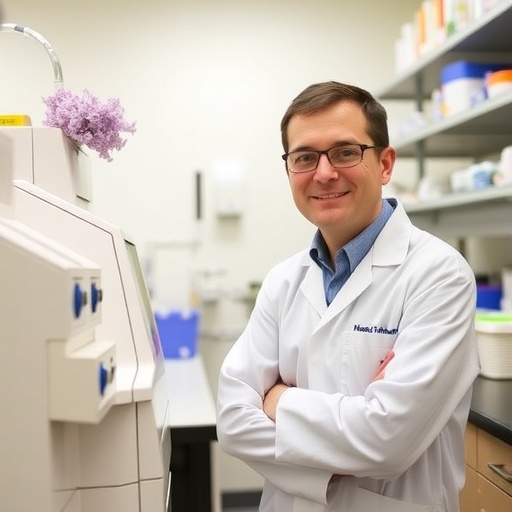In the relentless quest to unravel the mysteries of cellular maintenance, a breakthrough discovery has emerged from the laboratories of The University of Texas at Arlington, promising to reshape our understanding of how organisms manage the crucial process of waste removal at the cellular level. Alec Whited, a dedicated graduate researcher in biology, alongside doctoral student Aladin Elkhalil, has identified a novel cellular pathway that vastly improves the organism’s ability to clear dying cells—an insight poised to influence future treatments for autoimmune disorders and advance healing mechanisms.
Cellular waste management is an extraordinary process that sustains life, yet its intricate details remain enigmatic. As living things continuously generate cellular debris, the failure to efficiently remove apoptotic cells can lead to catastrophic biological consequences. Whited’s research, conducted within the Ghose Lab at UT Arlington and recently published in the prestigious journal Genetics, elucidates a pathway involving the orchestration of molecular players that facilitate the engulfment and degradation of these obsolete cells through phagosome closure—a pivotal step in waste clearance.
Understanding the biological significance of this process requires examining the intricate dance between cell debris and immune modulation. When cells undergo programmed death, they release intracellular components that, if not swiftly and properly cleared, can be misconstrued by the immune system as pathogenic threats. This misrecognition prompts an inflammatory cascade, laying the groundwork for chronic inflammation and autoimmune diseases. Whited’s findings shed light on the genetic regulators, specifically CDH-3/cadherin, YAP-1/YAP, and EGL-44/TEAD, which synergistically promote SYX-2/syntaxin and the EFF-1 fusogen, culminating in efficient phagosome closure—a necessary phase in cellular cleanup.
The mechanistic insights described provide a cellular blueprint for resolving inflammation-linked pathologies by ensuring the seamless removal of dying cells. Immune tolerance hinges on the silent clearance of apoptotic cells, sparing the organism from the pitfalls of hyperinflammatory conditions. This study’s revelation of the molecular cogs driving this process has profound implications not only for understanding autoimmune disease progression but also for therapeutic intervention strategies that target faulty cellular clearance mechanisms.
Beyond autoimmune implications, this study extends its scope to the realm of regenerative medicine and wound healing. The genes under scrutiny, particularly those influencing cell-to-cell fusion, hold the key to tissue regeneration—a fundamental biological process that restores integrity after injury. SYX-2/syntaxin and EFF-1 are integral to the fusion events that coalesce cells to mend disrupted tissue, accelerating wound closure and repair. Decoding these interactions may ultimately herald new approaches to managing chronic wounds and enhancing the body’s natural healing capacity.
Whited emphasizes that despite the promise of these findings, the path to therapeutic application remains complex, necessitating a deeper investigation into the genetic interplay and downstream molecular effects. His research opens a gateway for identifying additional genetic components and elucidating their roles in both cellular clearance and tissue repair, potentially enabling the development of targeted molecular therapies.
A notable element of this discovery lies in its interdisciplinary foundation—melding advanced imaging analysis techniques with molecular biology to visualize and elucidate the dynamic process of phagosome closure in animal models. Leveraging sophisticated microscopy and genetic tools, the team was able to delineate the roles of specific proteins in real-time, providing compelling evidence for how these molecular agents coordinate to navigate the biophysical challenges of membrane fusion and cargo degradation.
The significance of this research is also amplified by its support through esteemed funding agencies like The Cancer Prevention Research Institute of Texas and the National Institutes of Health, underlining the critical importance of foundational biological research in tackling complex diseases and promoting human health.
Moreover, the environment at UT Arlington played a crucial role in nurturing this scientific venture. Whited describes a collaborative and intellectually stimulating atmosphere within the Department of Biology, where shared enthusiasm among faculty and students fosters innovation and rigorous exploration. This supportive culture cultivates researchers who are not only equipped with technical expertise but are also deeply motivated to contribute meaningfully to the global scientific narrative.
In the broader context of biomedical research, this work embodies the essence of modern science—integrating genetics, molecular biology, and cell physiology to answer pressing questions about health and disease. It represents a vital step forward in understanding how cellular homeostasis is maintained and disrupted, providing new molecular targets for drug development and therapeutic intervention.
This discovery also resonates with the larger scientific community’s quest to decipher the cellular lifecycle, particularly apoptosis and subsequent clearance, which are fundamental to organismal health across species. The molecular pathways characterized by Whited and Elkhalil may be conserved across diverse organisms, opening avenues for translational research that bridges basic biology and clinical application.
Importantly, the study’s publication in Genetics, a journal renowned for disseminating cutting-edge biological insights, affirms the work’s high caliber and relevance. It not only highlights the technical rigor involved but also the potential of this research to catalyze advances in immunology, cell biology, and regenerative medicine.
As this research gains traction, it may inspire a wave of investigations probing deeper into phagosome dynamics, membrane fusion mediators, and the interplay of cadherin and YAP pathways in cellular clearance. Such endeavors could accelerate the pace at which novel therapeutic strategies for autoimmune diseases and wound management transition from bench to bedside.
In sum, the groundbreaking work spearheaded by Alec Whited and his collaborators encapsulates a profound advancement in our comprehension of cellular waste removal—a biological imperative. Their contribution paves the way for future innovations that could redefine treatment paradigms for autoimmune conditions and revolutionize approaches to tissue repair, underscoring the transformative power of fundamental research in the life sciences.
Subject of Research: Animals
Article Title: CDH-3/cadherin, YAP-1/YAP, and EGL-44/TEAD promote SYX-2/syntaxin and EFF-1 fusogen-mediated phagosome closure
News Publication Date: 3-Sep-2025
Web References: https://doi.org/10.1093/genetics/iyaf182
Keywords: Cell biology, Autoimmune disorders, Cells, Animal cells, Molecular biology




